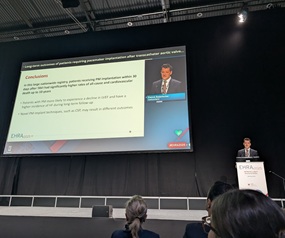
Pacemaker implantation within 30 days after a transcatheter aortic valve implantation (TAVI) procedure has been found to correlate with significantly higher rates of all-cause and cardiovascular-related mortality at up to 10 years of follow-up, as per data from the nationwide SwissTAVI registry.
Late-breaking results from this registry were presented by Patrick Badertscher (University Hospital Basel, Basel, Switzerland) at the recent European Heart Rhythm Association (EHRA) congress (30 March–1 April 2025, Vienna, Austria).
Within the SwissTAVI registry, researchers assessed a total number of more than 30,000 patients undergoing TAVI procedures in Switzerland between 2011 and 2022. They stratified these patients into three groups: those who already had a pacemaker implant prior to TAVI (n=1,366); those who received a pacemaker <30 days post-TAVI (n=2,028); and those who did not undergo any pacemaker therapy (n=9,966). The median age of this patient population was 82 years, 47% were female, and roughly one-third had a history of atrial fibrillation (AF).
The researchers’ primary endpoint was all-cause death evaluated at the one-year follow-up timepoint, as well as at five and 10 years of follow-up, while notable secondary endpoints included cardiovascular death, decreases in left ventricular ejection fraction (LVEF) ≥10%, and occurrences of heart failure (HF) symptoms.
As per the registry’s primary endpoint, all-cause mortality rates at one year revealed a significantly worse prognosis in patients who received a pacemaker <30 days post-TAVI compared to those who received no pacemaker therapy (hazard ratio [HR], 1.28). And, similarly, patients who had a pacemaker implant prior to TAVI also had a significantly worse prognosis as compared to those in the registry’s non-pacemaker group (HR, 1.39).
Analyses relating more specifically to one-year cardiovascular-related mortality ultimately revealed similar trends—patients who received a pacemaker post-TAVI experienced a significantly worse prognosis, on average, versus those who did not receive pacemaker therapy (HR, 1.39). However, those with a prior pacemaker implant did not experience statistically significantly worse prognoses compared to those without a pacemaker in terms of cardiovascular death (HR 1.28).
“When comparing patients receiving pacemaker therapy within 30 days after TAVI to patients with no pacemaker therapy, these patients had a significantly worse outcome regarding all-cause death and cardiovascular death at one year,” Badertscher told the EHRA audience, referencing conclusions from a model adjusted for multiple cardiac risk factors, before going on to outline results from extended follow-up data. “These findings were mirrored when using five-year follow-up data, and when using 10-year follow-up data, with significantly worse prognoses for patients receiving a pacemaker within 30 days after TAVI.”
This trend indicating inferior outcomes in patients implanted with a pacemaker post-TAVI—as compared to those without a pacemaker—was maintained across a number of additional study endpoints, including rates of decreased LVEF ≥10% and HF symptom occurrence, as well as a composite measure combining cardiovascular death, LVEF decline and HF symptoms.
Prior to concluding, Badertscher outlined a handful of the SwissTAVI registry’s limitations, such as its observational nature and resulting susceptibility to residual confounding, a lack of information on ventricular pacing during follow-up, and the fact that the potential clinical impact of different pacemaker types and indications was not assessed.
“Novel pacemaker implantation techniques, such as conduction system pacing [CSP], may result in different outcomes,” he added. “However, this is yet to be demonstrated in the TAVI population.”
Long-term outcome data from the SwissTAVI registry were also published in JACC: Cardiovascular Interventions shortly after Badertscher’s presentation.
According to Jens Cosedis Nielsen (Aarhus University, Aarhus, Denmark), who delivered a presentation reviewing these findings at EHRA, SwissTAVI raises the following question: Are we seeing the consequences of pacing-induced HF here?
“The signals are statistically and clinically significant—but, [as acknowledged by Badertscher in his presentation], the cardiovascular risk factors differed between groups and residual confounding cannot be excluded,” Nielsen said. “So, it is questionable whether pacing-induced heart failure is the reason why you observed the signal for worst prognoses in patients with a pacemaker after TAVI. I think that causality cannot be claimed. But I also think, as you said, these data very much support the conduction of studies of new pacing modalities to assess whether they will lead to an improved prognosis in patients requiring a pacemaker after TAVI.”









